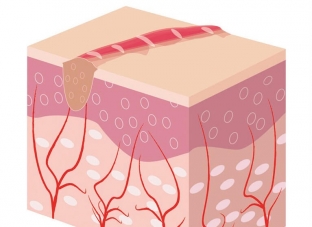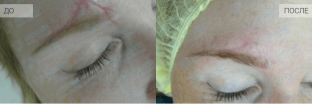As a result of injuries (physical, chemical, thermal effects, etc.) or operations in a person's life, an additional problem of an aesthetic nature appears – scarring. They are not dangerous to health, however, these formations on the skin cause psychological discomfort and spoil the appearance, especially if the places of their localization are parts of the body that are constantly or almost constantly open (hands, neck, face). Hypertrophic scars, like keloids, appear as a result of a violation of the normal healing process.
Hypertrophic scars – causes of
Hypertrophic scars – the result of excessive formation of connective tissue in the process of healing a damaged area of the skin. The extracellular matrix is responsible for the formation of all scars. In the case of various injuries, myofibroblasts, trying to eliminate tissue damage, begin to actively "send" collagen, elastin and other proteins into the wound, which lead to the formation of scars.

If the normal process of wound healing is complicated by the presence of inflammatory processes or other adverse factors, it triggers the process of collagen synthesis so active that there is an accumulation of too many proteins, the development of tissue fibrosis, which manifests itself in hypertrophic and keloid scars.
The only difference between keloids and hypertrophic scars is that hypertrophic scars do not grow beyond the wound, while keloids can grow in size.
Getting rid of hypertrophic scars – main treatments
For the treatment of hypertrophic scars, use:
- Compression (squeezing).
- Silicone plates.
- Ointments.
- Medications (corticosteroids).
- Cryodestruction.
- Cosmetic procedures – peels, laser resurfacing, dermabrasion, etc.
- Hyaluronidase.
- Interferon in combination with scar excision.
- Laser removal.
- X-ray therapy.
- Surgical removal (excision).
Timeliness is very important in the treatment of hypertrophic scars. The sooner you contact a specialist with a problem, the more likely it is to successfully fix the problem. If "age" the scar does not exceed a year, it is much easier to make it disappear than after its "aging".
Laser treatment at Linline Clinic – the best way to get rid of hypertrophic scars
What are the advantages of laser resurfacing over other methods of scar removal
A laser resurfacing technique that used to remove hypertrophic scars at the Linline clinic, is revolutionary in the field of scar removal. None of the available methods can provide the effect that is achieved with the help of laser equipment used by clinic specialists. The fact is that each method of scar removal has its drawbacks, so:
- ointments, creams and other conservative methods will not provide a pronounced effect;
- chemical peels are fraught with skin pigmentation disorders;
- surgical removal – an invasive procedure that will leave marks.
Advantages of laser removal of hypertrophic scars at Linline Clinic
- pronounced result (minimization of the severity of the scar – after the prescribed course of procedures, it becomes invisible);
- individual approach (treatment is selected according to the individual characteristics of the patient's case);
- soft effect (laser provides gentle resurfacing of the scar);
- promoting skin regeneration (stimulating the production of collagen and elastin under the influence of a laser beam, which leads to an accelerated and natural renewal of the treated area);
- exclusivity (Linline clinic uses a unique technique of gentle scar treatment – nanoperforation);
- Safety (the laser is gentle on the skin, careful control of radiation parameters avoids side effects typical of other procedures).



The doctor selects the most effective treatment in each case. Treatment of scars with traditional medicine will not only not provide the desired effect, but will also delay the visit to the doctor, which is necessary to effectively get rid of hypertrophic scars. Therefore, it is important to contact a qualified specialist in time to maximize the chances of eliminating this aesthetic problem.








Add a comment